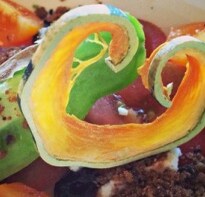Do you love potatoes more than life itself? Are you a cook who just cannot get enough cabbage? No, thought not. Still, if you eat seasonally and avoid air-freighted fruit and veg, such worthy perennials may be all you have had to play with for the past few months. It's a problem that brothers Matt and Iain Pennington, chefs at the Ethicurean, near Bristol, know only too well. Having pledged to use solely local, seasonal British produce, getting through winter and keeping the menu colourful has been a challenge. Their answer? Preserving ingredients.Now in their fourth year of business, they are constantly drying, salting and fermenting produce to call on year round. Which has introduced them to many weird and wonderful ingredients. "Year-on-year, the menu has got more interesting because we have this back larder of things that lend intense bursts of flavour," says Matt. Naturally, you want a kitchen filled with sunshine, 365 days a year. So how could you replicate what the Ethicurean is doing, at home?FermentingNoma's Rene Redzepi has predicted that fermenting will be the next foraging. The Penningtons agree. "The depth of flavour that can be achieved is unbelievable," says Iain. Moreover, by adding complementary spices to their ferments, the brothers have affected remarkable transformations - their fermented squash, flavoured with cassia, coriander seed, cumin and caraway, tastes "identical to passion fruit". Matt knew fermenting would bring out fruity and umami flavours in vegetables, not just the tartness associated with, say, kimchi or sourdough, but he was astonished: "We've created flavours we said we wouldn't use because we're not going to import fruit. It's something we never expected."
Advertisement
DehydratingNo moisture means no enzyme action, means no rot. More importantly, says Iain, who dries everything from beetroot to fish roe: "You're concentrating flavour." There are numerous ways in which the Penningtons play around with and augment dried ingredients, not least by fermenting them first and then drying them. In the case of marrow ("a hard thing to find a use for," says Matt), that process has produced fermented-dried "crisps" which, simultaneously, pack a salty, citrussy, savoury umami punch. Thus you have, says Matt, "a vegan element as tasty or strong as bacon" - not from an exotic Japanese ingredient but by using an underused vegetable.
Advertisement
Advertisement
For the latest food news, health tips and recipes, like us on Facebook or follow us on Twitter and YouTube.
Advertisement
Tags:
